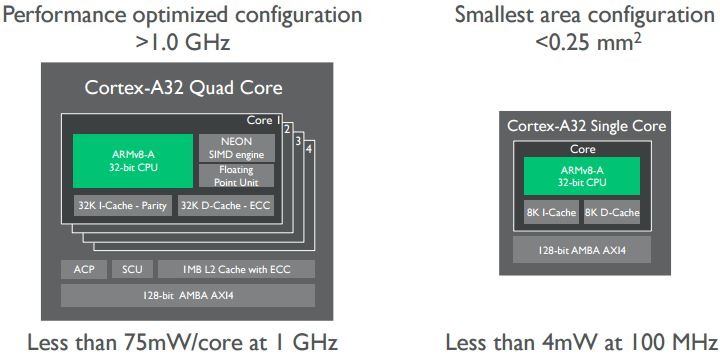ARM Cortex-A32 To Succeed Cortex-A5 And Cortex-A7 In 32-Bit Wearables, IoT Devices
ARM announced the new Cortex-A32 CPU core, which is the company’s smallest and lowest-power ARMv8-A processor yet. Although it’s made on the ARMv8-A architecture, Cortex-A32 is a 32-bit core chip.
“ARM offers an unrivaled portfolio of processors that power billions of extremely efficient embedded devices,” said James McNiven, general manager, CPU group. “The Cortex-A32 processor, enabled with secure ARM TrustZonetechnology, builds on the trail blazed by the Cortex-A5 and Cortex-A7 processors in embedded applications such as single-board computing, IoT edge nodes and wearables. It brings greater performance, efficiency and other benefits of the ARMv8-A architecture for ARM’s silicon partners to innovate on for richer, more secure embedded systems,” he added.
The new CPU core targets next-generation wearables, IoT and embedded solutions. It’s a direct 32-bit successor to Cortex-A5, while the Cortex-A35, announced earlier, will succeed Cortex-A7 for both 32-bit and 64-bit applications. However, Cortex-A32 can also be used in devices where 64-bit computing is not necessary.
The advantages of Cortex-A32 being made on the new ARMv8-A instruction set architecture include over 100 new 32-bit instructions that are available in the next processor, up to 13 times faster software encryption (enabled on all ARMv8-A chips), and enhanced media performance. It also supports security features such as ARM's TrustZone "Secure World," which can protect highly sensitive data such as cryptographic keys.
Cortex-A32 promises to be 25 percent more efficient than Cortex-A7 while delivering higher performance as well as 30 percent lower-power than the older Cortex-A5. It’s also 10 percent more efficient than the recently announced Cortex-A35.
Cortex-A32 is optimized to ship in configurations that have at least a 1.0 GHz frequency. At that clock speed, the power consumption is less than 75mW/core. At 100 Mhz, the core can use less than 4mW of power. The smallest configuration of a Cortex-A32 chip is only 0.25 mm2 when built on a 28nm process, which means it could be even smaller on 14nm or 16nm processes. Systems-on-chip can be configured to use from one to four Cortex-A32 cores.
Cortex-A32 is made for scenarios where high efficiency is needed, while still offering sufficient performance to power rich operating systems such as Linux, Snappy Ubuntu Core, Android, Android Wear, and so on. We should expect to see the Coretex-A32 in everything from devices such as as smart watches and mobile VR headsets to set top boxes, smart surveillance cameras, and even connected cars.
Get Tom's Hardware's best news and in-depth reviews, straight to your inbox.
Lucian Armasu is a Contributing Writer for Tom's Hardware. You can follow him at @lucian_armasu
Lucian Armasu is a Contributing Writer for Tom's Hardware US. He covers software news and the issues surrounding privacy and security.
-
nukemaster With many entry level NAS devices using SOCs like these, they will also find homes in those devices. I wonder if the little 100mhz one can be used for an audio media player. It is pretty light on power.Reply -
IInuyasha74 ReplyWith many entry level NAS devices using SOCs like these, they will also find homes in those devices. I wonder if the little 100mhz one can be used for an audio media player. It is pretty light on power.
I'd say it probably could. I believe my current 8 GB MP3 player I got around 2008 uses an older ARM CPU was clocked at 66 MHz, and that would be a significantly older architecture. Whatever additional audio components put inside would probably suck up more power at this point.
Nice article Lucian. -
bit_user ReplyAlthough it’s made on the ARMv8-A architecture, Cortex-A32 is a 32-bit core chip.
I'm not looking forward to this. Android already supports two flavors of ARMv7-A. Bifurcating ARMv8-A is just annoying, but I guess it has improvements they wanted even for 32-bit processors.
We should expect to see the Coretex-A32 in ... mobile VR headsets
That would definitely surprise me. It's too weak for self-contained headsets, and it doesn't seem worth the trouble of putting it in tethered headsets.



